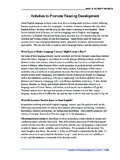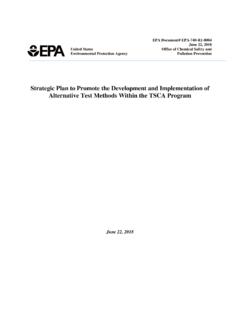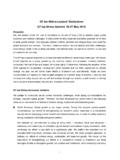Transcription of Fostering and Measuring Skills - OECD.org
1 Fostering and Measuring Skills : Improving Cognitive and Non-Cognitive Skills to promote Lifetime SuccessTim Kautz, James J. Heckman, Ron Diris, Bas ter Weel, Lex BorghansDirectorate for Education and SkillsCentre for Educational Research and Innovation (CERI)Education and Social AND Measuring Skills : IMPROVING COGNITIVE AND NON-COGNITIVE Skills TO promote LIFETIME SUCCESS This work is published under the responsibility of the Secretary-General of the OECD. The opinions expressed and arguments employed herein do not necessarily reflect the official views of OECD member countries. This document and any map included herein are without prejudice to the status of or sovereignty over any territory, to the delimitation of international frontiers and boundaries and to the name of any territory, city or area.
2 Photo credits: Shutterstock You can copy, download or print OECD content for your own use, and you can include excerpts from OECD publications, databases and multimedia products in your own documents, presentations, blogs, websites and teaching materials, provided that suitable acknowledgment of the source and copyright owner is given. All requests for public or commercial use and translation rights should be submitted to Requests for permission to photocopy portions of this material for public or commercial use shall be addressed directly to the Copyright Clearance Center (CCC) at or the Centre fran ais d exploitation du droit de copie (CFC) at 3 ACKNOWLEDGEMENTS This report was commissioned by the OECD through its project on Education and Social Progress.
3 We thank Linor Kiknadze and Edward Sung for valuable research assistance. We received helpful comments from Richard Boyle, Zidi Chen, Maryclare Griffin, Robert Lerman, Seong Hyeok Moon, Dan Moran, Maria Rosales, and Indra Wechsberg. 5 TABLE OF CONTENTS EXECUTIVE SUMMARY .. 7 INTRODUCTION .. 9 Discarding Obsolete Notions and Embracing the Findings of Recent Research .. 11 The Organisation of the Rest of the Paper .. 12 MEASURES OF COGNITIVE AND NON-COGNITIVE Skills .. 13 Cognitive Skills .. 13 Measuring Non-cognitive Skills .. 13 A Task-Based Framework for Identifying and Measuring Skills .. 16 Reference Bias.
4 18 Measuring Skills Using Behaviours .. 20 Are Non-Cognitive Skills Stable? .. 21 THE PREDICTIVE POWER OF NON-COGNITIVE Skills .. 23 Correlational 23 Evidence from the General Educational Development (GED) Programme .. 25 THE Skills NEEDED FOR SUCCESS IN THE LABOUR MARKET .. 29 A FRAMEWORK FOR UNDERSTANDING INTERVENTIONS .. 31 SUMMARY OF EMPIRICAL EVIDENCE ON THE EFFICACY OF INTERVENTIONS .. 33 EARLY-LIFE INTERVENTIONS THAT BEGIN BEFORE FORMAL SCHOOLING .. 35 Infant Programmes and Model Preschools .. 38 Nurse-Family Partnership .. 38 Jamaican Study .. 40 Perry Preschool Programme .. 40 Abecedarian Programme .. 42 Large-Scale Infant and Young Child Programmes.
5 43 Head Start .. 43 Chicago Child Parent Center (CPC) .. 44 EDUCATION AND INTERVENTIONS IN KINDERGARTEN AND ELEMENTARY SCHOOL .. 45 Targeted Non-Cognitive Skill Interventions .. 45 The Seattle Social Development Project (SSDP) .. 45 The Montreal Longitudinal Experimental Study (MLES) .. 47 Cambridge-Somerville Program .. 48 Project STAR .. 48 EDUCATION AND INTERVENTIONS TARGETED TOWARD ADOLESCENTS AND YOUNG ADULTS .. 49 Adolescent Mentorship Programmes .. 49 6 Quantum Opportunity Program .. 49 Becoming a Man .. 50 Pathways to Education Programme .. 50 Big Brothers Big Sisters .. 51 Empres rios Pela Inclus o Social (EPIS) Program.
6 51 H&R Block FAFSA experiment .. 51 Dartmouth College Coaching Program .. 52 Residential-Based Programmes .. 52 Job Corps .. 52 National Guard ChalleNGe .. 52 Workplace-Based Adolescent Intervention Programmes .. 53 Career Academies .. 54 Year-Up Programme .. 55 Self-Sufficiency Project .. 56 Apprenticeship Programmes .. 56 OTHER CURRICULA THAT HAVE BEEN APPLIED TO MULTIPLE AGE GROUPS .. 59 Tools of the Mind .. 59 Studies that Teach the Incremental Theory of Intelligence .. 59 Prevention vs. Remediation .. 60 THE EFFECTS OF EDUCATION AND PARENTAL INVESTMENT ON COGNITIVE AND NON-COGNITIVE SKILL .. 61 SUMMARY.
7 66 REFERENCES .. 67 Tables Table 1. The Big Five Domains and Their Facets .. 15 Table 2. Summary of Effects for Main Interventions .. 36 Table 3. Summary of Effects of the Nurse-Family Partnership .. 39 Table 4. Summary of Treatment Effects from the Seattle Social Development Project .. 47 Table 5. Summary of Treatment Effects from Career Academies within 96-Month Follow-Up after Scheduled High School Graduation .. 55 Figures Figure 1. Determinants of Task Performance .. 16 Figure 2. Decomposing Variance Explained for Achievement Tests and Grades into IQ and Non-Cognitive Skills : Stella Maris Secondary School, Maastricht, Holland.
8 18 Figure 3. National Rank in Big Five Conscientiousness and Average Annual Hours Worked .. 19 Figure 4. Associations with Job Performance .. 23 Figure 5. Correlations of Mortality with Non-Cognitive Skills , IQ, and Socioeconomic Status (SES) 24 Figure 6. Distribution of Cognitive Ability by Educational Status (No College Sample, All Ethnic Groups) .. 26 Figure 7. Hourly Wage Differences of GED Recipients and Traditional Graduates Compared to Uncertified Dropouts - Ages 20-39 .. 27 Figure 8. Distribution of Non-Cognitive Skills by Education Group .. 28 Figure 9. Framework for Understanding Skill Development.
9 32 Figure 10. Perry Preschool Program: IQ, by Age and Treatment 41 Figure 11. Histograms of Indices of Non-Cognitive Skills and CAT Scores .. 42 Figure 12. Casual Effect of Schooling on ASVAB Measures of Cognition .. 62 Figure 13. Casual Effect of Schooling on Two Measures of Non-Cognitive Skill .. 63 7 EXECUTIVE SUMMARY1 This paper reviews the recent literature on Measuring and Fostering cognitive and non-cognitive Skills . IQ tests and achievement tests do not adequately capture non- cognitive Skills personality traits, goals, character, motivations, and preferences that are valued in the labour market, in school, and in many other domains.
10 For many outcomes, their predictive power rivals or exceeds that of cognitive Skills . Evidence from the General Educational Development (GED) testing programme in the United States shows the importance of non-cognitive Skills . The GED is an achievement test which dropouts can take to certify that they are equivalent to secondary school graduates. The programme is based on the widely held belief that tests capture the important Skills learned in school. On the surface, the programme is successful. Based on test scores, GED recipients are just as smart as high school graduates. When it comes to outcomes that matter, such as college completion and labour market success, GED recipients perform much worse in the labour market and in a variety of other life domains than traditional secondary school graduates.
















